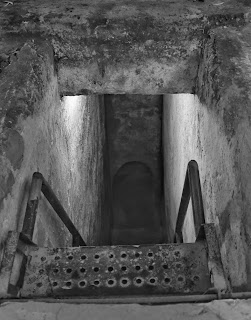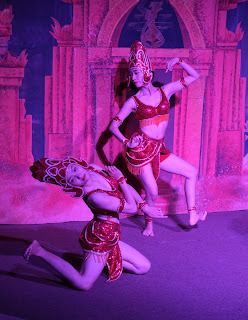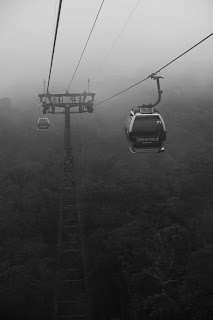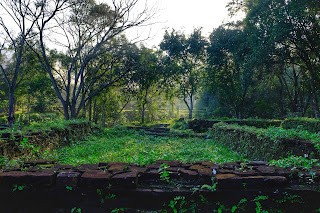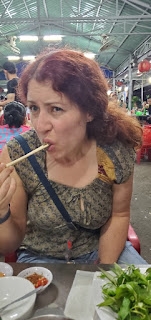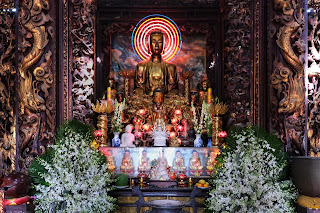We decided to take the big bus from Hoi An to Hue instead of a motorbike taxi. It’s a 3-8 hour drive depending on how many stops you make along the way. The Motorbike allows you as much time as you want to visit everything, but our bus only gave us about an hour at Marble Mountain - one of 5 mountains in the area that is littered with Buddha pagodas and caves. We could have easily spent 3 hours exploring all the hidden grottos, but the hour gave us enough time to run through 3 caves, rock climb out the back of a 4th cave, and take in the lake/city view spread out below the Water Mountain.
Pagoda at this top of Water Mountain - part of the Marble Mountains.
Robby at Marble Mountain.
We stopped at the top of Hai Van Pass, a curvy road that goes up, over the mountain range separating the two cities and gives you an amazing view of the valleys below on a clear day. There’s also an old Vietnamese Military outpost at the top where you can look out through gun turrets and stumble along old barrack ruins. At the bottom, on the Hue side of the hill, there’s Lăng Co - an oyster fishing inlet town of 400 people where we got to feel the breeze flowing off the blue lake, but not actually walk the sandy beach because we stopped at an abandoned resort hotel with barbed wire blocking the beach entrance. Our last bus stop was an old Japanese Bridge - Thánh Toan Tile-Roofed Bridge.
View of beach from Hai Van Pass.
Oyster Fisherman.
Once in Hue, we dropped our bags at The Dreamers Homestay and went exploring. After a bit of food, we tried to walk to the night market, which is across a small river running through the city, but ended up taking a riverboat instead because the lady selling the “ferry” only charged us 50 cents. Instead of going immediately across to the market - like 200 feet, we happily enjoyed a 20 minute river cruise at sunset before docking. The best part was that the lady who enticed us to take the boat noticed that we liked the fluffy puppy near the water’s edge, so she picked it up, handed him to me, and said get on the boat. So essentially we kidnapped a puppy and got a free boat cruise for 50 cents.
It was amazing with a cooling evening breeze and relaxing atmosphere where we got to see the city’s lights turn on - including the main bridge changing colors every three seconds in a pretty display of blue, green, yellow, and red. Also, the puppy was like “WTF, I’m on a boat?”, but then he seemed to know the boat driver and was wagging his tail happily once the boater held him.
The night market turned out to be a closing day market. We wanted street food, but all the little vendors sold various meat pieces in Pho. We did get Che- a dessert thing that consisted of various jellies and fruit goos dumped on top of ice and slathered in coconut milk. All the different flavors actually blended well together and it was refreshing, though not all that appealing to look at.
It happened to be Christmas Eve, so the hostel had made a dinner for everyone. We came at the end, but there were still some egg rolls and potatoes left to try. We made friends with a group of people, one of which was celebrating his birthday, so we all went to a bar and a dance club to celebrate with him. The dance club played some weird techno, but had a beautiful realistic LCD display of thunder and lightening storm clouds on the ceiling.
The following day we hired a private car to take us all over the city. First stop was Thuy Tien Lake - where a massive 2km water park was built in 2004, but mysteriously closed in 2006, having maybe never been officially used. The park included some water slides, a coliseum amphitheater, pagoda, kiddie water park, flight simulator, statue garden, and various other things that were all assessable by going through a 3-story Dragon at the entrance, which housed an aquarium, live crocodiles, and a view of the lake running through the park.
Dragon!
Robby going down the defunct water slide.
Since the park is now abandoned and nature is trying to reclaim its land, it’s closed to the public. You used to be able to bribe the guard at the front to let you in, but when we tried, he wouldn’t budge. So, we got inventive and hiked through the surrounding woods to find the hidden path that leads into the park (google is amazing on telling you how to break into closed places). Our trespassing trek lead us to a cemetery where a man was visiting a loved one. We waited until he was done praying before asking if he knew the way. Turns out he did, as he walked us all the way to the Dragon and helped us convince the scouting security guard to give us “5 minutes to take a photo”, in which we ran from the guard and hid in the bushes so we could see more of the park without him trying to kick us out. I think the guard just dissuades the meek from seeing the park, because about 7 other tourist were wandering around and a bunch of locals motorbiked past us while we spent an hour exploring.
Kiddie water park.
Inside Coliseum with Dragon in the background.
Cow chilling at the Coliseum.
Happy that we got to explore the mysterious and abandoned, we met back up with our driver and headed to the 3 main Royal Tombs people visit in Hue. There are a total of 7 Royal Tombs designed by Emperors of Vietnam from the early 1800’s to the early 1900’s. 4 of them are not very accessible or were damaged during WW1 and the Vietnam War. The tombs are not what one would typically think of as a tomb, but rather a large complex of Chinese looking buildings, gardens, and an outer wall guarding everything.
We visited the tombs of Khai Dinh - an Emperor that spent 11 years having his French and Chinese inspired final resting place built, Minh Mang- a traditionalist that died before his tomb was completed in 1843, and Tu Duc- the longest running Emperor who ruled for 35 years and died childless because of complications with Polio as a child. All of them were impressive and far to walk through.
Entrance to Khai Dinh’s tomb.
Minh Mang’s tomb.
Another part of Minh Mang’s tomb.
Statue outside Khai Dinh’s tomb.
Inside one of the buildings at Tu Duc’s tomb.
If we weren’t already exhausted from hiking through the woods to the water park and spending about three hours seeing the tombs, we also decided to visit the Imperial City in the center of town. In 1804, a 14km walled city was ordered built by Emperor Gia Long and was the seat of power for the Nguyên Dynasty until the French imposition in the 1880’s. There used to be about 160 buildings, but a bunch were destroyed in various wars, mostly the Vietnam War, and now only 10 major buildings exist with a few out lying ones.
After a day spent walking through history, we wanted to spend some time in nature. We booked an all day tour to hike Bach Ma National Park. After driving up a steep and windy road with a crazy driver who loves to speed around curves, we hiked to the peak’s viewing point and were rewarded with a semi clear view of the the valley below with a layer of fluffy clouds in between. Bach Ma used to be a French retreat with upwards of 200 villas spread throughout the mountainside and a lovely 4.5 hour hike to the community, but then the Japanese showed up in the 1940’s and kicked everyone out. Following the Japanese, the American’s took over before handing the mountain to the South Vietnamese, which lost it to the Viet Cong of the North. Eventually it was turned into a National Park and all the military stuff abandoned, but there are remnants of Viet Cong tunnels, which our guide walked us through.
The mountain has 5 beautiful lakes that all flow into each other and out to Vietnam’s largest waterfall - a 300-meter cascade. We had to use wire ropes to transverse the steep, rocky terrain to get to some of the lakes. There were also cables over the river crossings that most people failed to use correctly and got soaked shoes for their efforts, but I took the easy way over and jumped the river rocks. We lucked out and had a half sunny day, as opposed to the typical dreary and raining days winter in Hue usually offers.
Lake 1.
Robby crossing scary bridge with wire rope.
Our tour guide jumping into a lake.
The 300 meter waterfall, or the top of it. Biggest waterfall in Vietnam.
All in all, Hue wasn’t so bad. You really don’t need more than 2 days to see all the sights, but you can get by seeing almost everything in 1.5 days.

























